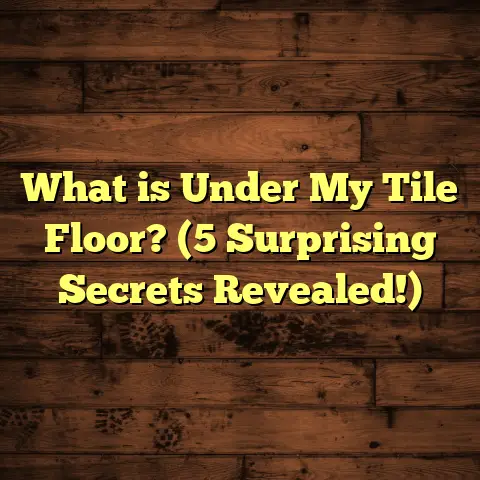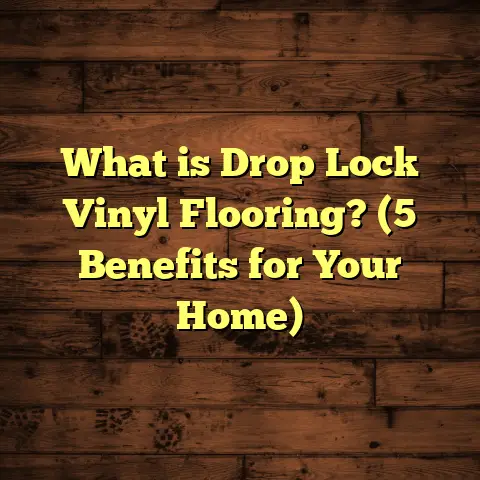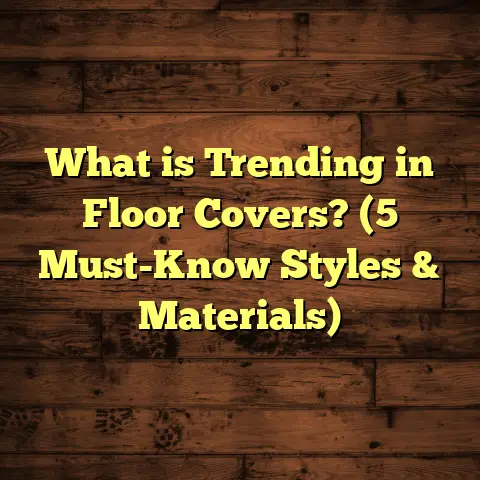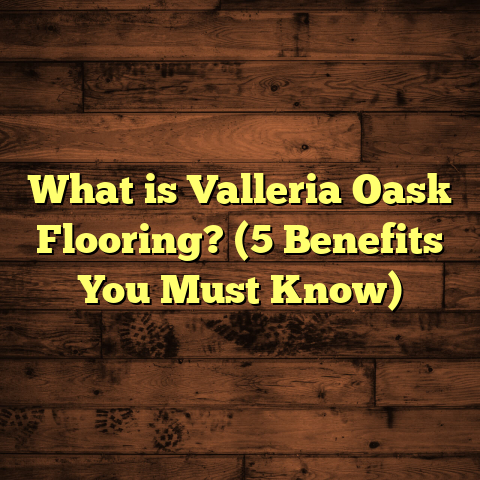What is Floor Covering? (5 Types You Need to Know Now!)
I still remember the time I showed up at a client’s house, ready to install brand-new flooring, only to find the previous floor was a disaster zone—uneven, cracked, and just plain ugly. The homeowner was frustrated and unsure about what type of floor covering to choose next. That moment really opened my eyes to how much people don’t fully understand what floor coverings are and how they can change a space completely. So, I’m going to share what I know, straight from my years on the job, to help you get comfortable with floor coverings and pick the perfect one for your home.
What is Floor Covering?
Simply put, floor covering refers to any material or product that is applied over the structural floor to create a finished surface. This surface is what you walk on, see, and interact with every day. It’s more than just decoration; it provides comfort, protection, and sometimes even insulation or soundproofing.
Floor coverings can be made from many different materials—wood, vinyl, carpet, tile, you name it—and each comes with its own set of benefits and challenges. When I first started installing floors, I thought it was all about looks. But over time, I learned how much the right floor covering can affect a room’s atmosphere, durability, and even your wallet.
Let me share some data that might surprise you: According to a report by the National Floor Covering Association (NFCA), homeowners who invest in quality flooring tend to see a 5-15% increase in their home’s resale value. Plus, the right floor covering can reduce maintenance costs by up to 30% annually. That’s why picking the right type isn’t just about aesthetics—it’s an investment.
In my experience, understanding floor covering options is key to avoiding costly mistakes. For example, I once had a client who chose solid hardwood for a basement without understanding moisture issues. Within months, the floors started warping. That’s why knowing what you’re dealing with upfront is so important.
So, what kinds of floor coverings should you know about? Here are five types that I recommend knowing inside out.
1. Hardwood Flooring: The Classic Favorite
I still get excited when I install hardwood floors. There’s something about the natural grain of wood that adds warmth and character to any room. Hardwood floors are made from solid wood planks, typically oak, maple, or cherry.
Why Hardwood?
Hardwood is extremely durable if properly maintained. I’ve had clients whose floors have lasted over 50 years! Plus, hardwood can be sanded and refinished several times, which means you don’t have to replace it frequently.
Here’s a cool stat: Hardwood floors can increase home value by about 2-5%, according to real estate experts. And they’re highly sought after by buyers.
My Experience
One memorable project was a century-old home where the original hardwood was covered with carpet. We stripped the carpet away and refinished the hardwood underneath. The transformation was incredible—it made the whole house feel authentic again.
Types of Hardwood
There are two main types: solid hardwood and engineered hardwood (more on engineered wood later). Solid hardwood is milled from a single piece of wood and is thicker than engineered wood planks. It’s best for above-ground areas because it can expand or contract with humidity changes.
Common species include:
- Oak: Very popular due to its hardness and beautiful grain patterns.
- Maple: Slightly lighter in color with a smooth grain.
- Cherry: Rich reddish tones that darken over time.
- Hickory: Known for its durability and rustic look.
Each species affects price and durability—oak tends to be affordable and sturdy; exotic woods like Brazilian cherry are pricier but very durable.
Installation Options
Hardwood can be nailed down onto wooden subfloors or glued down in some cases. Nail-down installation is common for solid hardwood and provides a strong hold.
Maintenance Tips
Hardwood needs regular cleaning with products designed for wood floors—never use water or harsh chemicals that can damage the finish. Also, placing rugs in high-traffic areas helps preserve the finish longer.
Challenges
Hardwood can scratch and dent easily—especially in busy households with pets or kids. It’s not recommended for bathrooms or basements unless treated specifically for moisture resistance.
2. Vinyl Flooring: The Budget-Friendly Workhorse
If you’ve ever wondered how some floors look like wood or tile but feel softer underfoot and cost less, vinyl is probably the answer. Vinyl flooring comes in sheets, tiles, or planks and can mimic almost any material thanks to advanced printing technology.
Why Vinyl?
Vinyl is water-resistant or even waterproof depending on the type. That makes it perfect for kitchens, bathrooms, and basements. Plus, vinyl is easy to clean and comfortable to stand on for long periods—something I appreciate when working on long installs.
Here’s some data from industry research: Vinyl accounts for over 30% of all residential flooring sales in North America. That’s huge!
Types of Vinyl Flooring
- Sheet Vinyl: Comes in large rolls; great for seamless installations which reduce water seepage risks.
- Luxury Vinyl Tiles (LVT): High-quality tiles that replicate natural materials like stone or wood.
- Luxury Vinyl Planks (LVP): Designed to look like hardwood planks; popular due to realistic appearance.
Personal Insight
I once installed luxury vinyl planks (LVP) in a busy family home with kids and pets. The homeowners were amazed at how easy it was to maintain compared to their old carpet. And the look? Spot on with the hardwood style they wanted but without the worry of damage.
Installation
Vinyl can be glued down or installed as a floating floor using click-lock systems—this flexibility makes it great for DIY projects or professional installs alike.
Maintenance
Cleaning vinyl is simple—just sweep or mop with gentle cleaners. Avoid abrasive tools that might scratch the surface.
Considerations
Lower-quality vinyl might fade or peel over time if exposed to sunlight or heavy wear. Also, vinyl doesn’t add much resale value compared to hardwood or tile but scores high in cost-effectiveness and practicality.
3. Carpet: Comfort Underfoot
Carpet has been a popular choice for decades because it adds softness and warmth that other floorings just can’t match. When I first started out, carpet installations were some of my favorite jobs—there’s something satisfying about rolling out a plush carpet and transforming a cold room into a cozy retreat.
Why Carpet?
Carpet provides excellent insulation against cold floors and helps reduce noise—perfect for bedrooms and family rooms where comfort is key.
Here’s an interesting stat: According to a survey by the Carpet and Rug Institute (CRI), homes with carpeted bedrooms have 20% better sleep quality reported by occupants due to sound dampening and warmth.
Types of Carpet Fibers
- Nylon: Durable and stain-resistant; ideal for high-traffic areas.
- Polyester: Soft feel but less durable; budget-friendly.
- Wool: Natural fiber that’s luxurious but expensive.
- Olefin/Polypropylene: Water-resistant but less resilient under heavy foot traffic.
Styles
- Cut pile: Plush texture; soft but shows footprints.
- Loop pile: Durable; good for commercial or busy homes.
- Cut-and-loop: Combines textures for patterned looks.
My Story
One of my clients had young kids who loved playing on soft surfaces. We picked a stain-resistant carpet with dense pile that could handle spills and rough play. Years later, it still held up well with just regular vacuuming.
Installation Notes
Carpet installation requires padding underneath for comfort and longevity. It’s usually stretched tightly over tack strips around room edges.
Maintenance
Regular vacuuming is key; professional steam cleaning once or twice a year keeps carpets fresh and allergen-free.
Downsides
Carpet can trap allergens like dust and pet dander. It also wears faster in high-traffic zones compared to hard surfaces.
4. Tile Flooring: Durable and Stylish
Tile has been around for thousands of years but today’s tile options are more varied than ever—from ceramic and porcelain to natural stone like marble or slate. I often recommend tile for areas that see moisture or heavy use because nothing beats its durability.
Why Tile?
Tile is waterproof and highly resistant to scratches and stains. That makes it a top choice for bathrooms, kitchens, mudrooms, and even living spaces if you want a sleek look.
Fact check: The global tile market size hit over $80 billion recently as more homeowners choose tile for longevity and style.
Types of Tiles
- Ceramic: Made from clay; glazed surface; affordable.
- Porcelain: Denser than ceramic; more water-resistant; pricier but durable.
- Natural Stone: Marble, granite, slate; unique looks but require sealing.
- Glass Tile: Decorative accents; reflective surfaces add light.
Installation Tips
Tile installation demands precision—proper subfloor prep, use of spacers for grout lines, and correct adhesive are essential to avoid cracking or unevenness.
My Favorite Project
We installed large-format porcelain tiles in a modern kitchen last year. The client loved how easy it was to clean after cooking messes and how stylish the subtle texture looked underfoot.
Maintenance
Tiles need grout sealing every few years to prevent stains. Cleaning is straightforward but avoid harsh chemicals on natural stone tiles.
Considerations
Tile can be cold and hard—pairing it with radiant floor heating makes sense if budget allows. Slippery tiles might need textured finishes in wet zones for safety.
5. Engineered Wood Flooring: Best of Both Worlds?
If you want the look of hardwood but need something more stable in humid spaces or easier to install yourself, engineered wood is worth checking out. It’s made of a thin layer of real wood on top of plywood layers that resist warping.
Why Engineered Wood?
Engineered wood holds up better in environments where solid hardwood might buckle due to moisture changes. It’s also often less expensive than full hardwood but still offers that authentic wood appearance.
Construction Details
The top veneer is real hardwood; underneath are several layers of plywood arranged crosswise for stability.
My Toolbox Story
I installed engineered wood flooring in a basement renovation where moisture was a concern. The client got the warm wood look without worrying about swelling or warping over time.
Installation Methods
You can glue it down, nail it, or install it as a floating floor using click-lock systems—this versatility suits many DIYers.
Maintenance
Engineered wood requires similar care as hardwood but is less prone to humidity damage.
What’s Important?
Not all engineered wood floors are created equal; thickness of the top veneer affects how many times you can refinish it—usually between 1-3 times versus multiple times for solid hardwood.
Bonus: Other Floor Covering Types Worth Mentioning Briefly
While the five above cover most homes’ needs, here are some other options you might encounter:
- Laminate Flooring: A synthetic flooring product simulating wood or stone appearances with a photographic applique layer under clear protective coating.
- Cork Flooring: Made from bark of cork oak trees; soft underfoot with natural insulation properties.
- Bamboo Flooring: Technically a grass species; looks like hardwood but grows faster making it eco-friendly.
- Concrete Flooring: Polished concrete floors offer industrial-chic looks with extreme durability but can be cold and hard without rugs or mats.
Installation Tips I’ve Learned Over Time
One thing I always tell clients is that even the best floor covering can look bad if installed poorly. Here are some tips from my years on-site:
- Subfloor Preparation: Whether plywood or concrete slab, your subfloor needs to be level, dry, clean, and structurally sound before any flooring goes down.
- Acclimation: For wood floors especially, let them acclimate in your home environment at least 48 hours before installation to prevent expansion issues later.
- Use Proper Tools: Using the right tools speeds up installation and ensures quality—for example, tapping blocks for click-lock floors or knee pads for carpet installers.
- Hire Pros Where Needed: Some flooring types like tile require expertise—improper installation leads to cracks or uneven surfaces.
I once tried DIY tile installation for my kitchen backsplash—not flooring this time—and learned firsthand how precise you have to be! It made me appreciate professional floor installers even more.
Maintaining Your Floor Covering: What Works Best?
Cleaning methods vary widely depending on your choice:
- Hardwood: Use microfiber mops with wood-safe cleaners; avoid standing water.
- Vinyl: Sweep regularly; mop with mild detergent.
- Carpet: Vacuum often; steam clean professionally every 6-12 months.
- Tile: Mop with pH-neutral cleaners; reseal grout lines yearly if needed.
- Engineered Wood: Similar care as hardwood; avoid soaking floors.
Also consider protective measures like felt pads under furniture legs to prevent scratches on hard surfaces or area rugs in high-use zones.
Common Mistakes I’ve Seen Clients Make (And How You Can Avoid Them)
- Choosing Floors Based Only on Looks
You might love how a flooring option looks online but ignoring practical factors like moisture levels or foot traffic leads to regrets later. - Skipping Subfloor Inspection
Sometimes underlying issues like rot or unevenness cause premature flooring failure if not addressed first. - Ignoring Manufacturer Instructions
Every flooring brand has specific installation guidelines—disregarding these voids warranties and causes problems down the line. - Underestimating Budget
Flooring costs include materials plus labor plus extras like underlayment or removal of old flooring—plan accordingly!
Cost Insights: How Much Should You Expect?
Floor covering prices vary widely based on material quality and location:
| Floor Type | Average Material Cost per Sq Ft | Average Installation Cost per Sq Ft | Notes |
|---|---|---|---|
| Hardwood | $6 – $12 | $4 – $8 | Species affects price |
| Vinyl | $2 – $7 | $1 – $3 | Luxury vinyl costs more |
| Carpet | $2 – $6 | $1 – $3 | Padding extra |
| Tile | $5 – $15+ | $5 – $10+ | Natural stone costs higher |
| Engineered Wood | $4 – $10 | $3 – $7 | Thickness affects price |
I always advise clients to get multiple quotes from local contractors because labor rates differ by region—but these ranges give a starting point for budgeting.
Final Thoughts From Me
Choosing the right floor covering isn’t always easy—you want something that looks great today but still performs well years down the road without breaking your bank or your back during installation.
If you keep your lifestyle needs in mind (kids? pets? moisture?), consider your budget realistically, and think about maintenance you’re willing to commit to—you’ll be much happier with your choice long-term.
And if you ever feel overwhelmed by options or costs, tools like FloorTally can help provide accurate local estimates quickly so you know what you’re getting into financially before committing.
Now I’m curious—which one caught your eye? Hardwood’s timeless charm? The practicality of vinyl? Or maybe cozy carpet? Let me know if you want advice tailored specifically for your home!
Happy flooring!





